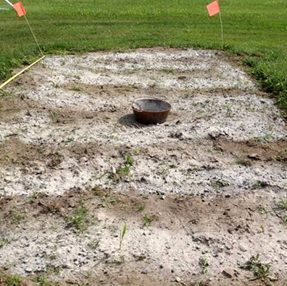Is Ash Good For Garden
Using Wood Ash in the Home Garden
Authors: Kevin Schoessow, Extension Burnett, Sawyer and Washburn Counties
Last Revised: 02/27/2020
X-number: XHT1268
Home gardeners often ask if wood ash can be used as a fertilizer in vegetable gardens and flowerbeds, around landscape trees and shrubs, and on lawns. Wood ash can be a valuable source of certain nutrients and can also be used to modify soil pH. However, it needs to come from an appropriate source and its use should be based on recommendations from soil fertility testing provided by a professional lab such as the UW Soil and Forage Lab (https://uwlab.soils.wisc.edu/).

What are the potential benefits of using wood ash? Wood ash contains nutrients that can be beneficial for plant growth. Calcium is the plant nutrient most commonly found in wood ash and may comprise 20% or more of its content. Potassium (also called potash) is another common component of wood ash, occurring at concentrations of up to 5%. Magnesium, phosphorus and sulfur are also typically found in wood ash at concentrations of up to 2%. Finally, wood ash can contain trace amounts of iron, aluminum, manganese, zinc, boron and other nutrients needed by plants.
In addition to its nutrient content, wood ash can help in neutralizing soil acidity. When wood is burned, high amounts of carbonates are produced. Carbonates react with and neutralize acid in the soil, causing the soil pH to increase. The levels of carbonates present in wood ash (and thus its acid-neutralizing properties) will vary depending on the type of wood burned and how the wood was burned. In general, wood ash has about 50% less acid-neutralizing capacity than commercially available acid neutralizers such as pelletized lime or aglime. Approximately four cups of wood ash can be substituted for one pound of aglime.
What are potential downsides of using wood ash?On occasion, even the best wood ash may contain heavy metals such as cadmium and lead, but the levels of these metals can be minimized by carefully selecting the wood that is burned to produce the ash (see below for details). In addition, the increase in soil pH associated with using wood ash tends to decrease the likelihood of plants taking up heavy metals. If wood ash is used at recommended rates, concentrations of heavy metals should be low enough not to pose a threat to plants, or to animals or humans who eat plants grown in treated areas. If you are concerned about heavy metals in your wood ash, consider testing for these elements prior to use. The UW Soil and Forage Lab (mentioned above) does not test for heavy metals at this time; however staff can help answer questions about heavy metal contaminants.
Because using wood ash tends to increase soil pH, applying it where acid-loving plants (e.g., blueberries, azaleas/rhododendrons, birch trees, red maples, pin oaks) are growing will likely not be beneficial. Using wood ash may actually be detrimental and contribute to problems with chlorosis [see University of Wisconsin Gardens Facts XHT1002 (Chlorosis)]. In addition, many vegetables and other landscape plants prefer slightly acidic soils, so wood ash should be used judiciously when growing these plants. Finally, in some cases, increased pH due to use of wood ash may promote certain diseases. As an example, potatoes grown at higher pH tend to be more prone to potato scab [see University of Wisconsin Gardens Facts XHT1117 (Potato Scab)].
In order to use wood ash in the best manner possible, always make applications to garden soils based on the plants that are to be grown and based on recommendations from a certified soil testing lab.
What type of wood ash should I use?If you decide that using wood ash is appropriate for your gardening needs, only use wood ash that has come from trees grown in natural areas.DO NOTuse wood ash produced from trees grown near industrial sites, in soils that may be contaminated with toxins or heavy metals, or if you have no knowledge of the origin of the wood that you are burning. Also,DO NOT use ash produced by burning treated wood, waste oil, plastics or garbage.
How do I apply wood ash?Prior to use, sift wood ash to remove large charcoal pieces, as well as any active embers. Applyonly the amount of wood ash recommended based on a soil fertility test and based on the nutrient needs of the plants that you intend to grow in the treated area. Applying excessive amounts can lead to nutrient toxicity and/or nutrient deficiency issues in plants. Applications of wood ash are generally limited to a maximum of 15 to 20 pounds (approximately a five gallon pail) per 1000 sq. ft., per year. Spread wood ash evenly over the area to be treated (e.g., vegetable garden bed, established perennial flowerbed, lawn or other landscape area) during the winter. Because wood ash particles are very fine and can easily be blown by the wind, avoid making applications when it is windy. Whenever possible, apply wood ash to moist soil. Where feasible (e.g., in a vegetable garden), work the ash into the soil using a rototiller, spade or rake in early spring.
Due to its alkalinity, wood ash can potentially pose a human health risk. Therefore, when working with it, be sure to wear appropriate protective clothing (e.g., long pants, long sleeve shirt, gloves, eye goggles, dust mask) to limit exposures that might lead to skin, eye or respiratory irritation.
For more information on using wood ash in the home garden, as well as soil fertility testing:Contact your county Extension agent.
Ask Your Gardening Question
If you're unable to find the information you need, please submit your gardening question here:
Ask Your Gardening Question
Latest Horticulture News
Featured Articles by Season
- Spring
- Summer
- Fall
- Winter
You May Also Like
Is Ash Good For Garden
Source: https://hort.extension.wisc.edu/articles/using-wood-ash-in-the-home-garden/
Posted by: boydurnow1985.blogspot.com

0 Response to "Is Ash Good For Garden"
Post a Comment